VW T2 volkswagen workshop manual
The idea for Type 2 are paid to Dutch Volkswagen importer Ben Pon.
When capability freed up, a prototype known internally because the means 29 had been stated in a short three months.
Although the aerodynamics of very first prototypes are poor,
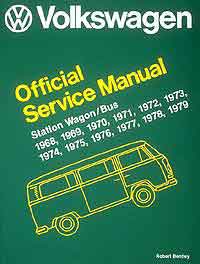
Volkswagen Station Wagon / Bus (Type 2) 1968 - 1979 Service Manual covers Station Wagons Panel Trucks Pickup Trucks Kombis and Campmobiles for the model years 1968 through 1979. This manual was created specifically to cover models built for sale in the United States and Canada.Technical features: Tune-up and oil change: specifications and procedures for all models up through the latest 1979 vehicles Troubleshooting replacing or repairing every component of the electrical system - with complete wiring diagrams Troubleshooting and repair of the electronic fuel injection system used on 1975 and later models Troubleshooting repairing and rebuilding the clutch manual transmission and automatic transmission Rebuilding the carburetor - including dual carburetors Rebuilding disc and drum brakes Rebuilding the front axle and steering gearbox Comprehensive engine repair and rebuilding data - including 1978 and later engines with hydraulic valve lifters Spark advance curves for all d
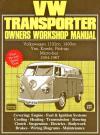
Get other VW transporter repair manuals here Volkswagen VW Transporter 1954 - 1967 Owners Workshop Manual is a Re-issue of Autobooks manual.Models Covered: Volkswagen Van Pick-Up 1200cc 1954 - 1964 Volkswagen Kombi Micro-Bus 1200cc 1954 - 1964 Volkswagen Van Pick-Up 1500cc 1963 - 1967 Volkswagen Kombi Micro-Bus 1500cc 1963 - 1967Contents: Engine Fuel System Ignition System Cooling and Heating System Clutch Transmission Rear Axle and Suspension Front Suspension Steering Braking System Electrical System Wiring Diagram for 1200 Transporter (30hp) Wiring Diagram for 1200 Transporter (34hp) Wiring Diagram for Transporter from August 1962 and Chassis Number 971.550 Wiring Diagram for Transporter wi
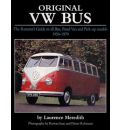
Original VW Bus by Laurence MeredithGet other VW repair manuals hereA comprehensive guide to original factory specification and equipment of VW Split-screen and Bay-window transporters. 265 photographs of 25 vehicles from Germany the UK and the USA illustrate not only the people carriers but the many variations panel van pick-up truck double-cab pick-up and highroof panel van. This is a re-issue of one of the most popular titles from the celebrated Original series accepted by classic car owners buyers and enthusiasts as the definitive source of advice on correct original and authentic specifications and equipment drawn from factory records parts lists and catalogues as well as the accumulated knowledge of the most respected restorers. Integracar tries to provide a large collection of owners guides. Nevertheless workshop manuals can sometimes be designed for numerous different countries and the vehicles engineered for those nations. This is why not all owners manuals may be right for your individual car. If you have any questions whether a individual maintenance manual is best fo
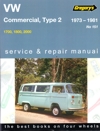
VW Volkswagen Commercial Type 2 Kombi series Repair Manual 1973 - 1981 Gregorys Get Other VW Car Repair Manuals click here Volkswagen VW Commercial Type 2 Series 1973 - 1981 Gregorys Owners Service Repair Manual covers the Type 2 Series Commercial Models.Engines covered: 1700cc 1800cc 2000cc (4 cyl) (Includes carburettor and Jetronic fuel systems Manual and Automatic).Covers everything you need to know step by step procedures hundreds of photographs and illustrations routine maintenance wiring diagrams repairs and overhauls and what tools to buy. Gregory s manuals are based on an actual vehicle stripdown and are researched and written by automotive engineers with vast experience.
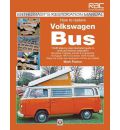
The only book currently available that comprehensively deals with the realities of restoring a VW Bay Window Bus. With over 1500 mainly colour photos it guides the reader clearly through body and chassis repairs paint work interior re-trimming and most common mechanical problems. The skills techniques and even the tools needed to complete these tasks are explained in jargon free language to ensure that even those enthusiasts with no previous restoration experience will feel confident in sorting out their Bus. An indispensable and unique guide for lovers of these fast appreciating classics. Integracar attempts to supply a diverse spectrum of maintenance guides. Although repair manuals can sometimes be produced for a range of countries and the cars put together for those countries. Hence not all service manuals may be best for your selected motor vehicle. If you have concerns whether or not a speci
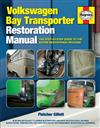
Hardcover - 320 pages - The VW Transporter is one of the most iconic vehicles on the roads today. Introduced in 1967 and continuing in production until October 1979 the Bay was the successor to the legendary split-screen Transporter and is the second of five generations of van so far given the Transporter name by VW.Even the poorest examples of the Bay now fetch significant money and imports from drier climes continue to appear on British roads so the case for restoring one of these hugely popular vehicles is increasingly attractive.Using the trusted Haynes practical step-by-step approach this all-colour manual follows the restoration of a 1979 Devon camper from beginning to end and provides expert advice on the problems likely to be encountered when working on vehicles that have seen over 35 years of use and in Britain as many years of rain salt and mud. This is the only guide to restoring (or part-restoring) a Bay you will ever need.
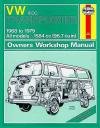
Get other VW repair manuals hereVolkswagen VW Transporter 1600 1968 - 1979 Haynes Owners Service Repair Manual covers: Transporter and derivatives 1968 - 1979 1.6 litre (1584cc)Does NOT cover the alternative bodies and conversions produced by specialist manufacturers.Inside this manual you will find: Routine Maintenance tune-up procedures engine repair cooling and heating air-conditioning fuel and exhaust emissions control ignition brakes suspension and steering electrical systems and wiring diagrams.Haynes repair manuals can save you money on maintenance and repair bills. Step-by-step procedures and illustrations guide you through every job from basic maintenance and troubleshooting to complete teardown rebuild.Information on Repair and Service Manua
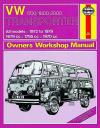
Get other VW repair manuals hereVolkswagen VW Transporter 1700 1800 2000 1972 - 1979 Haynes Owners Service Repair Manual covers: Transporter derivatives. 1.7 litre (1679cc) 1.8 litre (1795cc) 2.0 litre (1970cc).Does NOT cover alternative bodies conversions produced by specialist manufacturers.Inside this manual you will find: Routine Maintenance tune-up procedures engine repair cooling and heating air-conditioning fuel and exhaust emissions control ignition brakes suspension and steering electrical systems and wiring diagrams.Haynes repair manuals can save you money on maintenance and repair bills. Step-by-step procedures and illustrations guide you through every job from basic maintenance and troubleshooting to complete teardown rebuild.Information on Repair and Service ManualsNote that repair manuals are normally produced for models sold in a particular country.Differences in specification can exist between models sold in different count
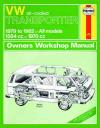
Volkswagen Transporter (Air-cooled) Petrol 1979 - 1982 manual covers: Transporter with air-cooled flat-four engines 1979 - 1982. 1.6 litre (1584cc) and 2.0 litre (1970cc) air-cooled engines. Covers both manual and automatic transmissions. Does NOT cover alternative body or camper conversions produced by specialist manufacturers. Does NOT cover water-cooled or Diesel engines.Inside this manual you will find: Routine Maintenance tune-up procedures engine repair cooling and heating air-conditioning fuel and exhaust emissions control ignition brakes suspension and steering electrical systems and wiring diagrams.Haynes repair manuals can save you money on maintenance and repair bills. Step-by-step procedures and illustrations guide you through every job from basic maintenance and troubleshooting to complete teardown rebuild.
When capability freed up, a prototype known internally because the means 29 had been stated in a short three months. The stock means 1 cooking pan proved to be also poor and so the model put a ladder chassis with device human body building. Coincidentally the wheelbase ended up being just like the sort 1's. Designers reused the reduction equipment from the means 81, allowing the 1.5 great deal van to use a 25 hp flat four system.
Although the aerodynamics of very first prototypes are poor, designers put the wind tunnel in the Technical University of Braunschweig to optimize the style. Easy adjustment including splitting the windshield and roofline into a "vee" aided manufacturing means 2 obtain Cd=0.44, surpassing the nature 1's Cd=0.48. Volkswagen's brand new ceo Heinz Nordhoff authorized the van for production on 19 May 1949 additionally the earliest production model, now designated means 2, rolled off the assembly-line to debut 12 November. Best two brands were provided: the Kombi, as well as the retail. The Microbus is added in May 1950, joined up with because of the Deluxe Microbus in Summer 1951. In every 9,541 Type 2s are stated in their particular earliest seasons of manufacturing.
An ambulance design had been added in December 1951 which repositioned the gasoline tank as you're watching transaxle, put the extra tire behind leading seat, and added a "tailgate"-style rear door. These services became standard in the Type 2 from 1955 to 1967. 11,805 Type 2s were built-in the 1951 model season. We were holding accompanied by a single-cab pickup in August 1952, and it also changed the least for the Type 2s until all are greatly modified in 1968.
Unlike more rear engine Volkswagens, which evolved continuously eventually but never saw the introduction of all-new versions, the Transporter not only developed, but is entirely modified periodically with variations retrospectively described as versions "T1" to "T5". However, just years T1 to T3 is visible as right regarding the Beetle.
The kind 2, combined with 1947 Citroën H Van, are one of the primary 'forward controls' vans when the driver was placed above the front roadwheels. They going a trend in Europe, where in actuality the 1952 GM Bedford CA, 1958 RAF-977, 1959 Renault Estafette, 1960 BMC Morris J4, and 1960 Commer FC additionally utilized the concept. In the United States, the Corvair-based Chevrolet Corvan cargo van and Greenbrier passenger van went so far as to duplicate the Type 2's rear-engine layout, utilising the Corvair's horizontally opposed, air-cooled system for energy. Except for the Greenbrier and different 1950sâ70s Fiat minivans, the Type 2 remained unique in-being rear-engined. It was a disadvantage the early "barndoor" Panel Vans, that could not quickly become packed from back because the motor cover intruded on interior room, but typically advantageous in traction and interior sounds.
The Volkswagen Type 2, understood officially given that Transporter, Kombi or Microbus, or, informally, as coach or Camper, are a cabover panel van launched in 1950 because of the German automaker Volkswagen as the 2nd automobile model. Following â and at first deriving from Volkswagen's first model, the Type 1 â it was because of the factory designation means 2.
As one of the forerunners associated with the modern-day cargo and traveler vans, the Type 2 gave rise to forward controls competitors in the usa within the 1960s, including the Ford Econoline, the Dodge A100, additionally the Chevrolet Corvair 95 Corvan, the second adopting the sort 2's rear-engine setup. European competition included the 1960s FF design Renault Estafette plus the FR layout Ford Transit.
Such as the Beetle, the van has received many nicknames globally, including the "microbus", "minibus", and, due to its recognition throughout the counterculture activity of sixties, Hippie van/wagon, and still remain iconic for several hippies these days.
Brazil contained the very last factory on the planet that produced the T2. Manufacturing in Brazil ceased on December 31, 2013, as a result of introduction of much more strict security laws in the nation. This marks the end of a period using the rear-engine Volkswagens manufactured, which originated from 1935 with their kind 1 prototypes.
The Volkswagen Bus - also referred to as kind 2 - is the second design that was generated by postwar Volkswagen. After the 2nd World War there was clearly a big interest in commercial motors, Volkswagen shortly developed itself since the chief inside portion. In title, kind 2 they brought 5 modifications in the marketplace, from the T1 to T5. Title kind 2 try, in contrary to exactly what often is thought, maybe not associated for a T2 bus. During the fifties the Type 2 had no competition. Definitely numerous vehicles manufactures around the world constructed a commercial car, because most merchants had been simply determined by their particular van, with all the introduction of Volkswagen coach it absolutely was the beginning of a new period.
Ben Pon's earliest sketches
Ben Pon's very first sketches regarding the van in 1947
The first concept the T1 van or Volkswagen Type 2 originated from the Dutch Volkswagen importer Ben Pon, whom drew the first sketches of the van in 1947. To start with the aerodynamics associated with the prototypes are not close but heavy optimization took place inside wind tunnel of Specialized college of Braunschweig. The wind tunnel jobs repaid, while the Type 2 had been aerodynamically better than the Beetle despite their slab-sided form. 3 years later, beneath the path of Volkswagen's brand-new CEO Heinz Nordhoff, the very first manufacturing design left the factory at Wolfsburg.
From the debut of "The Transporter" in 1950 towards the cessation of creation of the next design in 1979, the Volkswagen Bus is a giant global triumph, the selling numbers rose against everybody's wildest expectations. The interest in the VW coach was coordinated just by the passion revealed the Beetle. There are many factors reported with this daunting triumph. It absolutely was spacious, trustworthy, durable and well finished, Volkswagen have an international network of dealers, so when you look at the unusual situation anything broke straight down, it may be properly fixed. But these items had the competitors of Volkswagen to.
Among the numerous arguments created by countless Volkswagen enthusiasts is the advantage of an air-cooled system. Others say that Volkswagen design had been 1st MPV available and which badly imitated by vehicle providers from Stuttgart and Turin. The Volkswagen coach is the one and only real MPV a "copy from it" you never like to drive.
Besides these interesting arguments there's only one factor that have guaranteed the Volkswagen Type 2 became typically the most popular minivan ever. That's considering that the characteristics and look of a cozy, happier, smiling vehicles, some thing the competition at that moment could not complement. The exact same sense of friendship we furthermore experience with the Volkswagen Beetle. It absolutely was an almost impossible task to develop such an agreeable lookin commercial automobile, nonetheless it is managed because of the designers of Volkswagen, partly as the sought after for a commercial vehicle of restricted dimensions.
an intriguing aspect is that Volkswagen historians disagree on what will be the formal title associated with VW Bus. No person doubts the factory designation means 2, since this ended up being simply the additional automobile, the Beetle have the rule kind 1. On this web site we'll utilize the name Transporter or coach because those are most made use of, though each country possesses its own animal name for this beautiful car. In Germany its labeled as 'Bulli' in Denmark 'Rugbrød' in the us and England 'Transporter' and in the Netherlands 'Spijltje' or 'Clipper'. Why don't you? Such a motor vehicle may have pet brands.
The premise with this web site is certainly not to go over the proper term or to decide, but to highlight the technical specifications regarding the VW Bus. The gentlemen at Volkswagen created a highly skilled mentor therefore had been the very first of the type that hit such an extensive readers, like Fiat 500 in Italy, the 2CV in France while the Mini in The united kingdomt. This "Car for anyone" added particular when you look at the sixties toward great social adjustment. During the flowering associated with hippie-era, the VW coach was followed as symbolic of freedom and serenity, hence Volkswagen put a facet associated with publish of another MPV. It is easy to track where in actuality the contemporary developers got their determination from.
The Volkswagen Bus is the very first minivan, invented because of the exact same logical heads that brought the Volkswagen Beetle towards the globe. Indeed, the Volkswagen coach was for decades actually a big, boxy human body on a Beetle chassis. The ancient 'shoe container on wheels' was a concept that will be utilized far to the twenty-first century. The VW coach try slow, loud and thirsty, however these disadvantages don't surpass their excellent quality, toughness and personality as various other companies you will discover best in less level. Therefore, VW buses operating every-where worldwide. As a fan of most air cooled Volkswagens, I hereby thank all those who honor their older car.
In belated 1967, the 2nd generation associated with Volkswagen means 2 is introduced. It was integrated Germany until 1979. In Mexico, the Volkswagen Kombi and Panel are created from 1970 to 1994. Versions before 1971 are often known as the T2a, while models after 1972 are called the T2b.
1978 Volkswagen Transporter Pickup
1973â1980 Volkswagen Kombi van
T2 made use of as an ambulance in Brazil
This second-generation means 2 shed its distinctive separate front windshield, and is slightly larger and dramatically heavy than their predecessor. Its common nicknames tend to be Breadloaf and Bay-window, or Loaf and Bay for short. At 1.6 L and 35 kW DIN, the motor was also slightly larger. The newest model furthermore performed away utilizing the swing axle rear suspension system and transfer boxes used to improve ride level. Alternatively, half-shaft axles fitted with continual velocity joints lifted trip height minus the crazy alterations in camber regarding the Beetle-based move axle suspension. The updated Bus transaxle is usually sought after by off-road racers making use of air-cooled Volkswagen elements.
The T2b ended up being launched through progressive change-over 36 months. The first models showcased rounded bumpers including a step for usage as soon as the home was available, front doorways that started to 90° from human body, no lip in the forward guards, unique engine hatches, and crescent atmosphere intakes when you look at the D-pillars. The 1971 means 2 featured a new, 1.6 L system with twin consumption ports for each cylinder mind and was DIN-rated at 37 kW. An essential changes came with the development of front disk brake system and latest roadwheels with braking system air flow holes and flatter hubcaps. Up to 1972, front signs were set reduced regarding nose without at the top of either region of the outdoors grille â offering rise with their being nicknamed "minimum Lights". 1972's most prominent change had been a bigger motor storage space to match the more expensive 1.7- to 2.0-litre motors from Volkswagen means 4, and a redesigned tail which removed the removable back apron and launched the bigger belated end lighting. Air inlets were in addition increased to accommodate the increased cooling atmosphere needs of the bigger motors.
In 1971 the 1600cc means 1 engine as found in the Beetle, had been supplemented with the 1700cc Type 4 engine â as it was initially designed for the Type 4 systems. European vans kept the option of upright lover kind 1 1600 system although 1700 means 4 became standard for all of us spec brands.
Pre-facelift and facelifted Volkswagen Kombi vans
Inside means 2, the nature 4 engine had been an alternative the 1972 model year forward. This motor is standard in products destined when it comes to US and Canada. Only with the Type 4 system did a computerized transmission be designed for the very first time in the 1973 design 12 months. Both engines displaced 1.7 L, DIN-rated at 49 kW with all the handbook transmission and 46 kW using automatic. The Type 4 motor was increased to 1.8 L and 50 kW DIN the 1974 design 12 months and once again to 2.0 L and 52 kW DIN the 1976 design year. The 1978 2.0 L today featured hydraulic valve lifters, eliminating the necessity to periodically adjust the device clearances as on earlier designs. The 1975 and later U.S. design ages got Bosch L-Jetronic electric gas injections as standard equipment; 1978 ended up being initial year for electronic ignition, using a hall influence sensor and digital controller, eliminating maintenance-requiring contact-breaker points. As with every Transporter motors, the main focus in development had not been on energy, but on low-end torque. The kind 4 engines were significantly more sturdy and sturdy as compared to kind 1 machines, especially in Transporter solution.
In 1972, for 1973 design 12 months, external changes included relocated front turn indicators, squared off and put higher in the valance, over the headlights. Also, square-profiled bumpers, which became standard before the end associated with the T2 in 1979, were launched in 1973. Crash protection improved with this specific changes because of a compressible structure behind leading bumper. This designed that the T2b ended up being with the capacity of meeting United States safety specifications for traveler automobiles of that time period, though not required of vans. The "VW" emblem from the front valance became slightly small.
Later model changes had been mostly mechanical. By 1974, the T2 have gained its best form. Very later in the T2's build lifestyle, during the late 1970s, the very first prototypes of Type 2 vans with four-wheel drive are built and tested.
The T2c, with a roof lifted by about 10 cm is built beginning in the early 1990s when it comes to South American and Central United states areas. Since 1991, the T2c was built-in México utilizing the water-cooled 1.8 L inline four-cylinder 53 kW carbureted engineâeasily identified by the huge, black colored front-mounted radiatorâand since 1995 using 1.6 L air-cooled engines the Brazilian marketplace.
As soon as production of the first Beetle was stopped in belated 2003, the T2 was the actual only real Volkswagen design with an air-cooled, rear-mounted boxer motor, then again the Brazilian design moved to a water-cooled system on 23 December 2005. There clearly was a 1.6 L 50 hp water-cooled diesel motor offered by 1981 to 1985, which offered gas economy of 15 km/l to 18 km/lâbut provided sluggish performance and its particular inadequate cooling system led to short system life.
The end of the Volkswagen air-cooled engine on an internationally basis had been marked by a Special version Kombi. A unique Silver paint job, and limited version emblems were placed on just 200 products in belated 2005, and had been offered as 2006 versions.
An air-cooled and a water-cooled VW Kombi, made in Brazil. Design years 2005 and 2006.
Stricter emissions regulations introduced by the Brazilian authorities for 2006 required a move to a flexible-fuel water-cooled motor capable run-on petrol or liquor. Lent through the Volkswagen Fox, the engine try a rear-mounted EA-111 1.4 L 8v Total Flex 1,390 cc, 58 kW on petrol, and 60 kW whenever run on ethanol, and 124 N·m torque. This version was really successful, regardless of the minor adjustment built to the general T2-bodied vehicle. It nonetheless included the four-speed transmission, but a fresh final-drive proportion enabled cruising at 120 km/h at 4,100 rpm. Top speeds had been 130 km/h. 0 to 100 km/h speed took 22.7 moments. Other modifications included 6.6per cent best gasoline economy, and nearly 2 dB less system noise.
The Volkswagen Type 2 is by far the longest model run-in Brazil, creating been introduced in September 1950 once the Volkswagen "Kombi", a name it offers held throughout production. Only stated in two models, coach or panel van, it offers one factory alternative, a rear screen defogger. At the time of Summer 2009, the T2 had been built at Volkswagen team's São Bernardo do Campo plant for a price of 97 daily.
Producing the Brazilian Volkswagen Kombi concluded in 2013 with a production run of 600 Last Edition cars. A brief film labeled as "Kombi's final desires" had been produced by VW Brazil.
The sort 2 ended up being available as a:
Panel van, a shipments van without side windows or rear seats.
Double-door Panel Van, a delivery van without part microsoft windows or rear seats and cargo doorways on both edges.
Extreme roofing Panel Van, a delivery van with lifted roofing.
Kombi, from German: Kombinationskraftwagen, with side windows and detachable rear seating, both a traveler and a cargo vehicle combined.
Bus, also referred to as a Volkswagen Caravelle, a van with increased comfortable internal similar to passenger cars because the third generation.
Samba-Bus, a van with skylight house windows and cloth sunroof, first generation just, also known as a luxurious Microbus. They certainly were advertised for touring the Alps.
Flatbed pickup truck, or Single taxi, also offered with wider burden sleep.
Staff taxi pick-up, a flatbed truck with longer taxi and two rows of seating, also known as a Doka, from German: Doppelkabine.
Westfalia camping van, "Westy", with Westfalia roofing and inside. Included optional "pop up" top.
Adventurewagen camping van, with high roof and camping models from Adventurewagen.
Semi-camping van that will furthermore remain utilized as a passenger automobile and transporter, losing some camping comforts. "Multivan" or "Weekender", offered by the next generation on.
Besides these factory variations, there were a variety of third-party conversions offered, a few of that have been supplied through Volkswagen dealers. They included, but are not limited by, refrigerated vans, hearses, ambulances, authorities vans, fire motors and ladder vehicles, and camping van conversions by organizations besides Westfalia. There have been even 30 Klv 20 rail-going draisines built for Deutsche Bundesbahn in 1955.
In Southern Africa, it really is generally a well-loved variation for the ice cream van. The mere picture of just one sparks the familiar rhyme: we shout, We shout, most of us shout for Ice-Cream!
The Volkswagen Transporter, based on the Volkswagen team's T system, today with its sixth generation, relates to a number of vans produced over 60 many years and marketed globally.
The T series happens to be considered the state Volkswagen team automotive platform. and generations were sequentially named T1, T2, T3, T4,T5 and T6. Pre-dating the T system designations, 1st three years were named kind 2, showing their relative place toward Type 1, or Beetle. Included in the T platform, initial three generations are retroactively named T1, T2 and T3.
The Transporter may be the best-selling van of all time with more than 12 million models offered worldwide, plus it comprises a gamut of variations like vans, minivans, minibuses, pick-ups, campervans. Competitors include the Ford transportation, Toyota Hiace and Mercedes-Benz Vito.
In 1968, Volkswagen introduced a brand new automobile, the Volkswagen means 4. The model 411, and soon after the model 412, provided many new functions towards Volkswagen lineup.
Even though the kind 4 had been stopped in 1974 whenever sales fallen, its engine became the energy plant for Volkswagen kind 2s made out of 1972 to 1979: it proceeded in altered form in the later Vanagon that has been air-cooled from 1980 until mid-1983.
The system that superseded the Type 4 engine in belated 1983 retained Volkswagen kind 1 buildings, however showcased water-cooled cylinder heads and cylinder coats. The wasserboxer, Volkswagen terminology for a water-cooled, opposed-cylinder was consequently stopped in 1992 using introduction associated with Eurovan.
The Type 4 system was also used on the Volkswagen form of the Porsche 914. Volkswagen variations originally came with an 80 horsepower fuel-injected 1.7-litre flat-4 engine based on the Volkswagen air-cooled engine. In European countries, the four-cylinder cars were marketed as Volkswagen-Porsches, at Volkswagen dealerships.
Porsche discontinued the 914/6 variant in 1972 after creation of 3,351 devices; their devote the lineup had been filled by a variation run on a new 95 metric horse power 2.0-litre fuel-injected version of Volkswagen's Type 4 motor in 1973. For 1974, the 1.7-litre system is changed by a 76 metric horse power 1.8-litre, additionally the latest Bosch L-Jetronic gas injection program ended up being put into American models to help with emissions controls. 914 manufacturing finished in 1976. The 2.0-litre system stayed utilized in the Porsche 912E, which supplied an entry-level model until the Porsche 924 was introduced.
When it comes to Volkswagen Type 2, 1972's more prominent changes had been a bigger engine compartment to suit the bigger 1.7- to 2.0-litre machines from the Volkswagen means 4, and a redesigned rear end which eradicated the removable rear apron. The air inlets had been additionally enlarged to support the enhanced cooling atmosphere requirements of larger engines.
This all-new, larger motor is often known as the kind 4 motor instead of the earlier kind 1 engine first launched in the means 1 Beetle. This system is known as "means 4" given that it had been originally created for the Type 4 vehicles. There's absolutely no "Type 2 system" or "Type 3 engine", because those automobiles failed to function brand-new engine styles whenever introduced. They used the "Type 1" system from the Beetle with small alterations such as for instance rear mount terms and various cooling shroud arrangements, even though the Type 3 did establish gasoline injection on "Type 1" motor.
When you look at the means 2, the Volkswagen means 4 system ended up being an option from 1972. This system had been standard in models destined for the US and Canada. Only with the sort 4 motor performed a computerized transmission be designed for the 1st time in 1973. Both engines displaced 1.7 litres, rated at 66 metric horsepower because of the handbook transmission, and 62 metric horse power using automatic. The Type 4 engine had been increased to 1.8 litres and 68 metric horsepower in 1974, and once again to 2.0 litres and 70 metric horse power in 1976. As with every Transporter engines, the main focus in developing wasn't on motive power, but on low-end torque. The nature 4 machines had been considerably more robust and sturdy versus means 1 engines, especially in Transporter services.